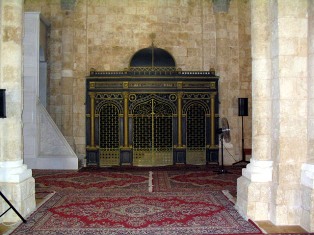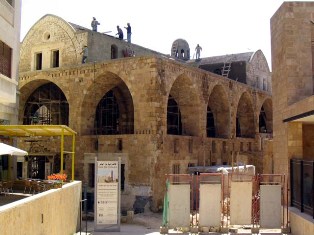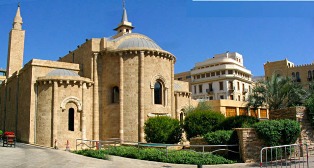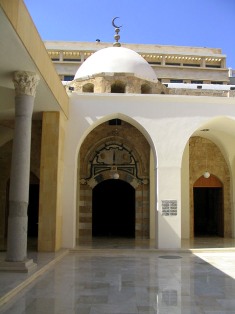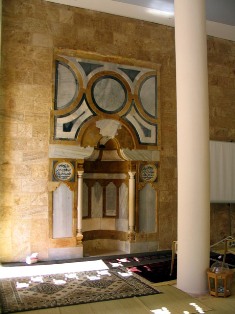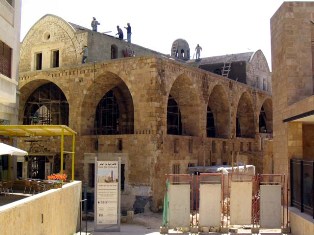An excerpt from the Safar-nama of Nasir Khusraw:
“From Byblos we went to Beirut, where I saw a stone arch situated so that the road ran right through it. I estimated the arch to be fifty ells high and on all sides were slabs of white stone, each of which weighed over a thousand maunds. This edifice was made of bricks up to a height of twenty ells. On the top, marble cylinders were set up, each eight ells tall and so thick that two men could scarcely reach around. On top of these columns were more arches on both sides, of such exactly fitted masonry that there was neither plaster nor mud in between the blocks. Above this was a great arch right in the middle, fifty cubits high. I estimated that each stone in that arch was eight cubits long and four wide, so that each one must have weighed approximately seven thousand maunds.
All these stones had designs carved in relief, better in fact than one usually sees executed in wood. Except for this arch, no other edifice remains in that area. I asked what place this had been and was told that it was said to have been the gate to the Pharaoh’s garden and was extremely old. The whole plain thereabouts abounds with marble columns, capitals and bases, all of carved marble; round, square, hexagonal and octagonal and of a kind of stone so hard that iron makes no impression on it. Yet there is no mountainous terrain nearby from which the stone might have been quarried and all other stone there is soft enough to be hewn with iron. In the outlying regions of Syria there are more than five hundred thousand of these fallen columns, capitals and bases and no one knows what they were or from where they were brought.”
Source: Thackston, W. Wheeler McIntosh, ed. trans., Nasir- i Khusraw’s Book of Travels (Costa Mesa, CA: Mazda Publishers, 2010), 18-19.
Beirut is the capital city of the present-day Lebanon. The name is likely to have been derived from the Hebrew be’erot (well), plural of be’er, the only local means of water supply until the Roman period. As a human habitat the site is prehistoric. Traces of the Acheulia and Levalloisian periods have been found there. During an obscure period of twelve centuries Beirut underwent the passage of armies coming up from Egypt or descending from Mesopotamia, among which were those of Ramses II in the 13th century BCE, and of Asarhaddon, the King of Assyria, in the 7th century BCE.
The Arab conquest of Beirut: After the Arab conquest, a new era began for Beirut. The city was repopulated during the reign of the Umayyad Caliph Mu‘awiya (r. 41-61 AH / 661-680 CE). At the same time, Persian colonists arrived to settle in its surrounding area. The old industry of sericulture (silk farming) was revived and commercial relations were resumed, at first with Damascus and then with Egypt. In 364 AH / 975 CE, the Byzantine Emperor John Tzimisces conquered the city, but shortly after that the Fatimids took it over from the Byzantines. Arab geographers of 4th-5th AH / 10th-11th CE centuries (such as al-Yaqubi and al-Maqdisi) mention Beirut as a fortified city under the jurisdiction of the jund (military district) of Damascus. In 492 AH / 1099 CE, the Crusaders came along the coast from the north but did no more than provision themselves at Beirut on their expedition to conquer Jerusalem.
Beirut in the Medieval Period: During the medieval period, conventionally considered to be 4th-9th AH / 11th-15th CE century, possession of Beirut was a powerful trump card due to the occurrence of two rare 'strategic' materials; wood, from the pine forest south of the city, and iron from the mines nearby. In the 7th AH / 14th CE century, commerce was disrupted as rivalries broke out at the port between the Genoese and Catalans. The Mamluk Princes reinforced their defences: the generals, Tanghiz in Syria and Barquk in Egypt (who claimed sultanate to himself, and founded Burji dynasty in Egypt in 794 AH / 1390 CE), each constructed a tower. As a result of the increased defense measures, Beirut survived and flourished. In the 9th AH / 15th CE century, Beirut was still the meeting place for the silk merchants, and a place of produce of citrus fruits that were exported to the court at Cairo, Egypt.
In 1595 AH / 1634 CE, during the reign of Fakhr al-Din b. Maan (a Druze Prince under the Ottomans), the city reached new heights of prosperity. Trade with Venice was strengthened and the exports of silk surpassed those of citrus fruits. By the middle of the 18th century, Beirut was the second densely populated coastal city in the region, after Tarabulus (Tripoli).
Beirut after the Russo-Turkish War: During the Russo-Turkish War of 1735-1739, Beirut suffered significant destruction. The city was bombarded several times. It finally fell into the hands of the Russians in 1773. In 1840. A further bombardment of Beirut by the combined forces of the Austrian, English and Turkish fleets, led to severe disruptions in the city's commerce. However, Beirut recovered, and developed rapidly, for the several following decades.
During the French Mandate (1920-43), it became the capital of an independent state and the seat of parliament and administration for the country. In 1958, the population of Beirut was more than 200,000, predominantly Arab, and, nearly doubled during the week with the daily influx of villagers, workers and merchants coming into the city from the surrounding areas.
Today, three universities (American, French and Lebanese), a National Library, and numerous international academic establishments make Beirut one of the important intellectual centres of the Arab Middle East. The city has also resumed its prominence as a centre of commerce.
Citation
“Bayrut.” Encyclopaedia of Islam, Second Edition. Brill Online, 2012.
http://referenceworks.brillonline.com/entries/encyclopaedia-of-islam-2/b... [Accessed June 2013]
Daftary, Farhad. A short history of the Ismailis. (Princeton, NJ: M. Wiener, 1998).
Hunsberger, Alice C. Nasir Khusraw, the ruby of Badakhshan. (London: I. B. Tauris, 2000).
Jidejian, Nina. Beirut through the ages. Beirut: Dar el-Machreq. (distribution: Librairie orientale, 1973).
Al-Harithy, Howayda. "Weaving Historical Narratives: Beirut's Last Mamluk Monument." Muqarnas no. 25.
http://www.archnet.org/publications/6786 [accessed February 2014]
Al-Omari Mosque Restoration
http://archnet.org/sites/523 [accessed February 2014]
Redevelopment of Beirut City Centre
http://www.archnet.org/sites/5023 [accessed February 2014]
